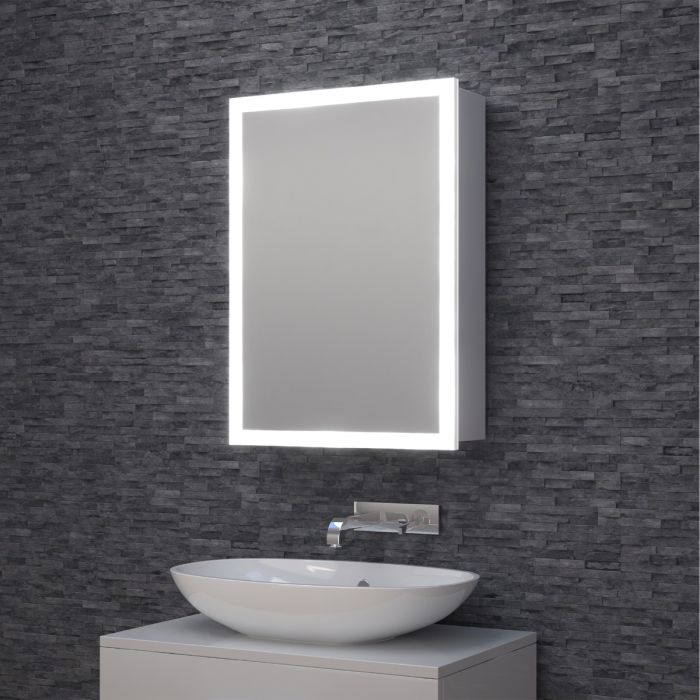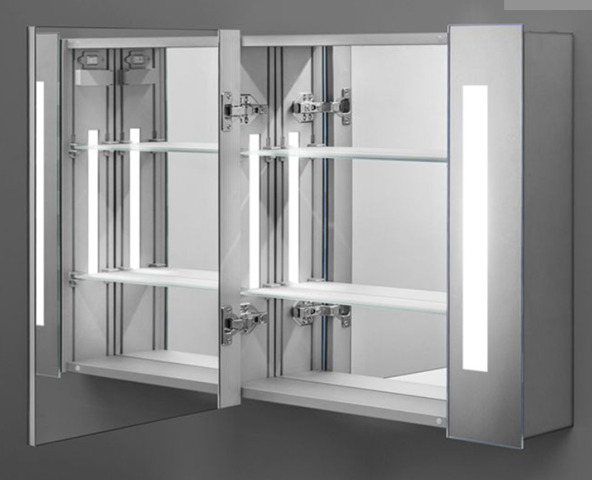The Advantages of Bathroom Mirror Cabinets
A bathroom mirror does more than just reflect; it also serves to brighten an area and adds flair and sophistication to places.
If you have wall space above your wash basin or vanity unit, you’re probably thinking about adding a mirror or a mirrored cabinet to complete the new design. Because mirrors and cabinets compete for the same wall space, the question of which to choose arises frequently when planning a bathroom interior.

Bathroom Mirror Cabinet with LED dot formation lighting
While there are some obvious advantages to both alternatives, we have compiled a list of considerations to consider when determining whether to go with a mirror or mirrored cabinet to help you make your own decision.
How big is the bathroom?
First, assess the size of the room. Smaller rooms generally necessitate smaller mirrors or cabinets, and for smaller bathrooms and en suites, a slimline mirror is often most suited to the space. Slimline mirrors provide bathrooms a sleek and flowing appearance that may be used in both modern and traditional schemes, depending on the design. If this is high on your priority list, look into slimline mirrors with additional functions.
Mirrored bathroom cabinets, on the other hand, offer the versatility of giving considerable storage space to help keep areas clutter-free and clean in larger bathrooms. Choosing two cabinets or mirrors for bathrooms with double sinks will provide harmony and visual balance in the room.

Where will the mirror or cabinet be hung?
The wall on which the cabinet or mirror will be hung must be large enough, and cabinets must have enough room on either side of the doors to avoid colliding with other items. It is preferable to avoid placing cabinets in corners of rooms so that the doors may fully open.
You should also keep in mind that cabinets and sinks are frequently placed opposite a bathroom door. This helps to avoid a cabinet’s side being the most apparent aspect in a room, which can frequently appear barrier-like from an interior aesthetics standpoint.
When deciding on the size of the cabinet or mirror, consider the furniture proportions in the space. To help create a streamlined image, the mirror or cabinet should not be wider than the piece of furniture or basin that it rests over. Because any misalignment will be more visible with straight-edged mirrors and cabinets, matching up with either the basin or vanity unit below is essential for a cohesive design.
Do you require storage?
It is critical to prioritise whichever solution works best in practise. Consider whether you require the mirror to be multifunctional or merely a mirror.
If storage is a need, cupboards with shelves for toiletries and accessories may be worth considering to keep other surfaces clutter-free.
After determining whether you require storage, design the objects that will be kept in the cabinet so that you have an idea of the height requirements for your shelf. The flexibility to move shelving up and down is sometimes neglected, yet it allows you to modify and bend your storage to your specific needs.
Multifunctional mirrors and cabinets
Consider whether you require any additional functions, such as shaver sockets, music, or digital clocks, before making your decision. All of these characteristics are as useful to have in the bathroom without the need to bring in other parts that may become water damaged, such as mobile phones and external speakers.
Mirrors can be simply included into an interior design scheme and furniture styling. Choose organic shapes with smooth edges, such as rounded or pebble shaped mirrors, for a more natural, easy aesthetic. Straight edged mirrors are likely to work better stylistically in areas that are more symmetrical or planned around harsher lines.

